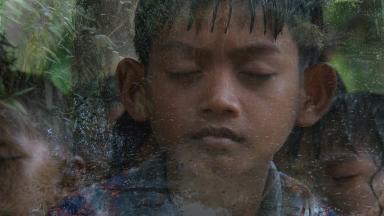Transmission of the Invisible: filled with visible beauty

Journeying through the performances at this year’s "PuSh Festival":http://pushfestival.ca/index.php is like being invited to a wine tasting where none of the labels are familiar and the genres blur, making it difficult to know what to expect in advance. "Tribal Crackling Wind’s":http://tribalcracklingwind.ca/ piece, *Transmission of the Invisible*, along with Peter Chin’s untitled solo, used a multi-disciplinary approach, incorporating mostly dance and video, to address Cambodia’s horrific past; after reading the description of the work, I was very excited to see these two pieces and although I liked them, I actually went away feeling like the use of many modes of performance actually distract from, rather than enhanced the themes being addressed.
Chin’s solo was less interesting to me than the ensemble piece that followed. Although Chin himself is an interesting performer, I found that the solo fell just short of being moving in any clear way. At the beginning of the eight minute piece, Chin enters the stage wearing all black and he seems nervous, as though unsure if he wants to perform or not. This sense of insecurity is parlayed into a kind of humour by which Chin moves downstage, fidgets as though he is preparing to rehearse, clears his throat and then turns as if he is deciding to leave the stage before coming back, chuckling and continuing to work his way into a solo whose movement vocabulary snatches lines from ballet and verses from Asian, most likely traditional Khmer, dance.
The soundtrack has some frenetic drumming and some high-pitched and intense vocals, which are fascinating, but the odd thing is that Chin seems to be playing a character whose uncertainty of himself within the dance actually detracts from the intensity of the rest of the aesthetics of this piece. Chin is, no doubt, an enjoyable dancer to watch; he moves around the stage freely and with fluidity but there was something about the character that he seemed to be playing that kept me from being absolutely absorbed into the piece, and this was frustrating to me as so much of the rest of the stage really came to life in this performance. The background set was an interesting construction that was at once an abstraction evoking perhaps clouds or water, as well as it was a screen onto which video was projected, the music was exciting, but the solo, with its shifting moods and self-conscious style, kept falling just short of pulling me in. Still, it left me intrigued enough that I was looking forward to the second part of the show.
*Transmission of the Invisible* is the centerpiece of the evening. It uses five dancers to interpret Chin’s journey to Cambodia (he has Cambodian heritage in his family line) and his reaction to the fact that during the rule of the Pol Pot, 90% of dance theatre artists were killed. Knowing this, Chin was left wondering how Cambodian dance was and could continue to be transmitted from one generation to the next in a country with a gaping wound torn through it. This question and the circumstances that surround it provoked Chin to honour not just what has been lost but also what has managed to be passed down through what he refers to as a “collective, heightened state of transmission of the invisible.” It is through this state that, Chin believes, individuals become part of something larger than just themselves. By entering into history, he feels, individuals become part of the bridge that overcomes the wounds and ruptures in history.
The intensity and the depth of the premise of Transmission made me eager to drink from its glass. And in many ways it delivered. The beautifully designed and executed costumes had a richness that evoke another place, the lighting was subtly suggestive, the soundtrack which ranged from drums to the sounds of the jungle at night was captivating, and much of the choreography was original and successful in its fusion of styles.
There were, however, some elements that I felt undercut rather than enhanced its message. Projected onto a “screen” on the back wall of the stage were a series of images that ranged from abstractions of water or trees to very literal images of people, faces, situations. During the moments when the images were evocative rather than obvious, I was much more able to be absorbed in the dance; for example when the images suggested the frenzy of fireflies at night or the languid undulation of swimming fish, I was enchanted. But when the less subtle images took over, I found myself struggling to concentrate on the dance, and actually felt like I had to choose between the dancers or the screen. It almost seemed like there were two narratives, two performances going on at once, and without a clear point of enmeshment, it was challenging to absorb either of the two.
Still, the dancers in this work are all, as individuals, enjoyable to watch. They interpret Chin’s work with commitment and with absorption into the choreography that makes them all interesting. As a whole, *Transmission of the Invisible* is aesthetically quite beautiful, and is certainly highly evocative of another time and another place. I can’t say that I was moved in the way I had expected from a piece with such a lofty premise, and because of this there were moments when my attention flagged; however, in its attention to the details of beauty, Peter Chin’s work is one that sits well on the palate.
_Transmission of the Invisible ; Choreography, Music, Costume Design Peter Chin Dancers Sean Ling, Andrea Nann, Heidi Strauss and Yim Savann and Phon Sopheap (Cambodia); Video installation Cylla von Tiedemann; Music Peter Chin, Garnet Willis Sound installation Garnet Willis; Set Design David Duclos; Lighting design Arun Srinivasan. For more information, go_ "here":http://pushfestival.ca/index.php?mpage=shows&spage=main&id=76#show



